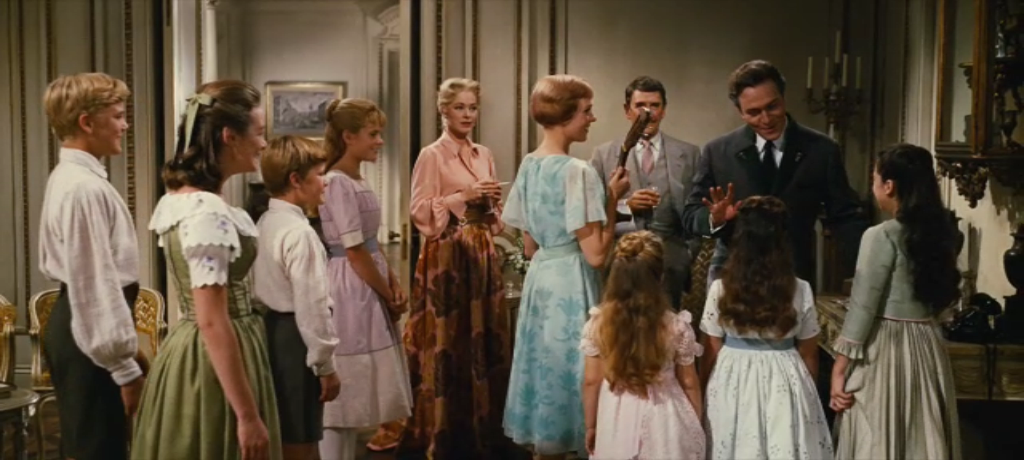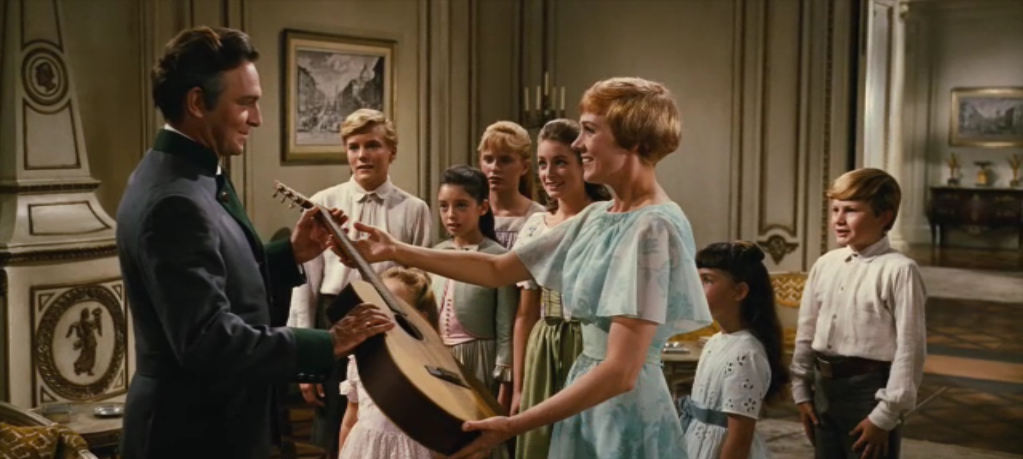I ran into two troubles while determining a favorite shot from Robert Wise’s The Sound of Music (1965). The first trouble is that some of the film’s best shots—Maria raising her arms to the hills, etc.—are already so iconic they’re ubiquitous, and I wanted to profile something a little less obvious. The second trouble is that the movie is seriously long, and I never schedule myself nearly enough time to get things done. I resolved this second problem by accepting that I would have to select a shot from the first half of the movie and leave the second half to the better organized people also participating in the Film Experience’s #HMWYBS challenge.
I nearly went with a frame from the “Sixteen Going on Seventeen” number, where the lightning glinting off the glass gazebo creates a tension that is somehow romantic, exciting, beautiful, and ominous all at once. But in the end I settled on Captain von Trapp turning down Maria’s offer to play the guitar, which arrives at about 1:24:35.
 The composition of the shot exemplifies two of the things The Sound of Music does really well: It acknowledges that Julie Andrews is the film’s unquestionable star (her blue dress cuts the frame and its mostly neutral palette in half), without making her the focal point of every single frame (it had to have been tempting), and it conveys several characters’ responses to the same set of events. Maria, Max, the Baroness, and the children all have their eyes on the Captain but are seeking answers to very different questions.
The composition of the shot exemplifies two of the things The Sound of Music does really well: It acknowledges that Julie Andrews is the film’s unquestionable star (her blue dress cuts the frame and its mostly neutral palette in half), without making her the focal point of every single frame (it had to have been tempting), and it conveys several characters’ responses to the same set of events. Maria, Max, the Baroness, and the children all have their eyes on the Captain but are seeking answers to very different questions.
The shot also bears the weight of wrapping up the tensions between characters that define the first half of the movie while also introducing subplots that will become important in the second half. Sensing Captain von Trapp’s feelings for Maria, the Baroness will remove herself from the emerging love triangle and leave him to his children and governess-wife. And confirming the Captain’s pride in his children’s harmonizing, “Cousin” Max will press even harder to feature the family in his upcoming folk performance.
With his hand in the air, von Trapp walks from his position in this frame to the other side of the room. He seems to be fleeing Maria’s guitar and his insisting children, but when Maria, the guitar, and the children follow him there, we realize that it is Max and the Baroness that have been left behind.
 When Maria again offers the guitar–and he accepts–it is as if she has passed him a torch and the responsibility for resolving the family’s problems have shifted from her shoulders to his. He then sings his emotional rendition of “Eidelweiss,” and if The Sound of Music were simply a story about reopening a wounded father’s heart to love and his admiring progeny, it could end here. But alas, the Nazis…
When Maria again offers the guitar–and he accepts–it is as if she has passed him a torch and the responsibility for resolving the family’s problems have shifted from her shoulders to his. He then sings his emotional rendition of “Eidelweiss,” and if The Sound of Music were simply a story about reopening a wounded father’s heart to love and his admiring progeny, it could end here. But alas, the Nazis…
A+ wonderful wonderful piece. This series was originally meant to celebrate cinematography but it often ends up being a celebration of how all the individual pieces of a story come together through great direction in single images or choreographed movements/moments. Which is fine.
this scene is so moving. I hope you join us every week.
Wonderful insight into the scene and a great catch on the subtle use of color to make Julie stand out. I’ve never noticed how even though they are all in pastels Julie’s is just ever so slight more vivid and singular to make her pop. It’s a terrific reading of the underlying emotion of the scene too.